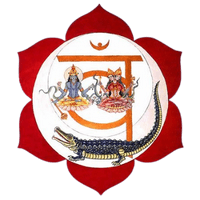
Svadhisthana Chakra
Table of content
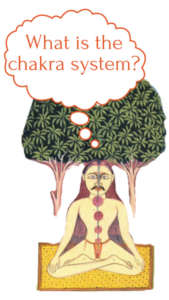
Human Chakra system
...
Chakras are mentioned in Tibetan sources, for example in the well-known “Atlas of Tibetan Medicine” and in Chinese treatises.
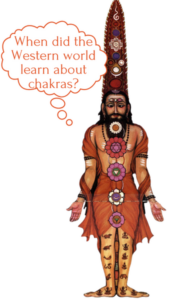
...
Rudolf Shteiner, the founder of the Anthroposophical Society made the next step in understanding the Chakra system. He noticed that chakras are opening up, not because of the rise of kundalini, but as a result of developing certain skills and qualities.
...
In parallel with Shteiner, psychology approached the issue of the Chakra system at the same time. Wilhelm Reich, who was later recognised as the founder of the body-oriented (somatic) psychotherapy, discovered that a person's psychological issues lead to the formation of the muscular tensions localised in the form of seven muscular segments, each of which is associated with a specific group of problems.
...
Connection of emotional states to the specific parts of the body is reflected in the linguistic expressions, such as “a heavy head”, “a hard-headed person”, “a lump in the throat”, “a tight chest”, “a weight lifted off the shoulders”, and “a lump in the stomach”.

First translations into English (and first pictures in the West)
...
Unfortunately, many inaccuracies have crept into this translation by Arthur Avalon.
For example:
15. Inside (Svadhisthana), there is a shiny white area of water shaped as a crescent moon, and bija VAM is within it, sitting on a crocodile, immaculate and white like the autumn Moon.
The translation is with inaccuracies
15. Inside [svadhisthana], there is a shiny circle of a white lotus belonging to Varuni. [Meditation shall be done] on the one who sits on Makara (Varuna), immaculate, who has bija “Vam”, appears as a crescent moon, shining like the autumn Moon.
The specified translation
Position of Svadhisthana chakra
Location of Svadhisthana in a body
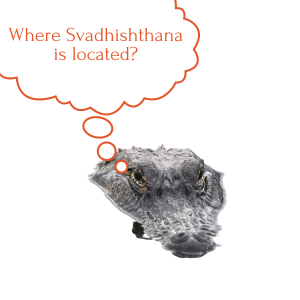
Chakra as a projection of emotions to the body, Chakra "petals".

svādhiṣṭhānaṃ liṅga-mūle ṣaṭpatraṃ cakram asya ca॥122॥ pūrvādiṣu daleṣv āhuḥ phalāny etāny anukramāt। praśrayaḥ krūratā garva-nāśo mūrcchā tataḥ param
It is a home for the energy of desire. The fruits on the petals, starting from the eastern one, are called:
praśraya — respect, courtesy, humility, love, attachment;
krūratā — rigidity;
garva-nāśа — destruction/pride/arrogance;
mūrcchā — drugging, ignorance, stupor;
avajñā — contempt;
aviśvāsa — mistrust.

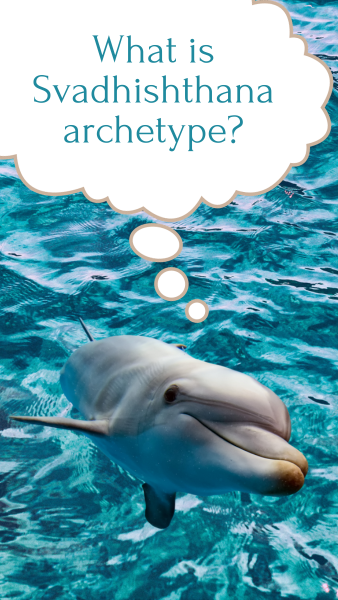
Chakra as an archetype
However, due to his genius, Jung captured the essence: chakras indeed correspond to the archetypes, although not to the one he presumed. The description of these archetypes we even could find in “Shat-chakra-nirupani”. For example, regarding Svadhisthana it says:
tasyāṅka-deśa-kalito harir eva pāyāt nīla-prakāśa-rucira-śriyam ādadhānaḥ । pītāmbaraḥ prathama-yauvana-garva-dhārī śrīvatsa- kaustubha-dharo dhṛta-vedabāhuḥ ॥16॥


Thanks to what does a child (or a baby animal) quickly acquire skills? It's because they learn through playing. And as soon as play is replaced by serious activity, it becomes tiring and inefficient in terms of learning.
Playfulness is just one of the manifestations (petals) of Svadhisthana. There is also sexuality, which prompts interaction with other people, and pleasure, which deepens our emotional experiences, and other petals.
Searching for experiences related to Svadhisthana – either it is sex, delicious food, or surfing – a person masters the ultimate reality available to them: their own body. Discovering Ishvara begins with the understanding of Prakriti, and it is impossible without fully embracing your own materiality and physicality. In my view, this is the profound essence of teachings within the Tantra cluster.
Furthermore, Svadhisthana is a body chakra and serves as a bridge beyond corporality, as it is the first transpersonal chakra. Where else can a person forget themselves, their ego, if not in a vivid sexual experience? To feel the body of a partner as one's own, to discover the existence of energy and subtle, invisible connections between people, such as a sexual context. No wonder that one of the epithets of the God of Love, Kama, in Ancient India, was “Mara” — the Killer. Climax, as the Greeks said, is a little death. And death is a pretext for a new birth.
Overall, without delving deeper, Ishvarapranidhana over Svadhisthana is the readiness to fully understand one's corporality, surrendering to one's desires and emotional experiences.

The destruction of the ego is the superpower of Svadhisthana
svādhiṣṭhānākhyam etat sarasijam amalaṃ cintayed yo manuṣyas tasyā'haṅkāra-doṣādika-sakala-ripuḥ kṣīyate tatkṣaṇena (18)
18. For a person who contemplates on this unstained lotus, which is called Svadhisthana, countless enemies like ego (ahanakara) immediately vanish.
Why ego (ahanakara)? Perhaps because truly intense sexual experiences are transpersonal, and in them, a person forgets about their self-conceptions, complexes, and thoughts, which constitute the essence of ego (ahanakara).
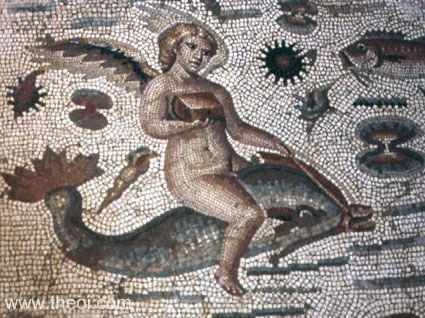
Symbol of Svadhishthana
In the images, the winged god Eros (the Roman Cupid) rides the sea on the back of a dolphin. In one hand, the god of love holds a box, and in the other — the reins of the dolphin. He is surrounded by fish and mollusks.
Video about desire – as the core emotional experience of Svadhisthana
A bit earlier, we described the structure of Svadhisthana, where the essential emotional experience lies at its core (in this case, Kama — desire), and there are its aspects at the periphery — on the petals.
Development of Svadhisthana

Rudolf Steiner, the founder of the Anthroposophical Society, observed that chakras open not during the ascent of Kundalini but during the development of new skills and qualities.
What qualities are these?
One of them is sexuality.
Yulia Yaroshenko tells about the development of sexuality:
“Sexuality manifests not only in the act of sex, but also in fantasies and erotic sensations. It is when it extends beyond the bed that sexuality begins to fulfill a person, deepening emotional experiences with their partner. This is what one should strive for! There are several ways to develop this aspect: deep self-reflection, exploration of erotic fantasies that arise in relation to the partner, and a broader study of this topic. For example, studying erotic cultures and various fantasies, noticing what resonates and excites you personally.”

One more quality of Svadhisthana is a skill to tempt.
So, do you need only cultivate new qualities to open a chakra? Not only… the development of any chakra involves distinguishing between behaviors that lead to the destruction of the chakra and those that enhance and develop the chakra.
Why read so much about svadhisрthana, you may ask? And argue, “it’s much better to practise!”
Svadhisthana in Ancient Indian Temples
Khajuraho Sculptures / खजुराहो
There is a hypothesis about how Khajuraho preserved its sculptures. For a long time, the town was neglected and overgrown with jungle. It was only in the 19th century that the English “discovered” it, so the city was able to avoid puritanical cleansing.
Eroticism of Odisha – Konark, Bhubaneshwar
Among all Hindu temples in India, the Sun Temple of Surya in Konark has the highest concentration of erotic sculptures, depicting all 64 types of amorous play mentioned in the Kamasutra by Vatsyayana. The Sun Temple in Konark is considered the most beautiful and simultaneously the most indecent building in the world.
Parashurameshvara Temple in Bhubaneshwar
The Sun Temple is not the only temple with erotic figures in Odisha.
The figures below are from the Parashurameshvara Temple in Bhubaneshwar, a ruined temple of Shiva in Bankadagada from the 6th century near Banapur (140 km from Konark to the southwest), and Brahmeshwara in Bhubaneshwar (11th century).
Modhera Sun Temple in Gujarat
The Modhera Sun Temple in Gujarat is also decorated with erotic sculptures.
“Erotic sculpture in India is part of a much broader manifestation of the erotic element in art and life, religion and philosophy of all people for approximately one and a half centuries of its history.” – “The Cult of Desire” by Kanwar Lal
Our favorite quotes about Svadhisthana
Books about emotional experiences of Svadhisthana
In any sphere of our lives, continuous self-education is necessary for serious study of anything, and thus, reading books.
Literature on sexuality is abundant with numerous profanations or superficial technical instructions. Sometimes it's challenging to filter out truly valuable works.
📚 "Kama Sutra" (translated by A. Ya. Syrkin)
Often presented as a collection of various positions, the most famous book on sex is not about that. We recommend reading it to anyone interested in developing sexual awareness.
📚 "The Body in History" by Jacques Le Goff - helps to understand how historical stereotypes and negative attitudes towards the body and bodily expressions were formed in European society.
📚 "Sex in World Cultures" by Zbigniew Lew Starowicz - as the title suggests, provides a detailed panorama of various sexual cultures on our planet in all their diversity.
📚 "My Secret Garden" by Nancy Friday - an excellent collection of women's erotic fantasies.
📚 "The Function of the Orgasm" by Wilhelm Reich - a deep psychological analysis of the relationship between sexuality and the overall fulfilment of personality.
📚 Human sexual rights
📚Ovid "The art of love"
📚Marquis de Sade
📚 Memoirs of Casanova
📚 Kama Samuha
📚 Vidyapati "Love Songs"
📚 Kalyana Malla “The Ananga Ranga (Stage of Love)”
📚 Shunga (Japanese erotic art)
📚 Robert van Gulik "Sexual Life in Ancient China"
📚 Jolan Chang "The Tao of love and Sex"
📚 Eduard Fuchs "Erotica", "Bourgeois Age. Conveyor of Pleasures", "Gallant Century. Banquet of Passion", "Renaissance. The Revelry of the Flesh"
📚 Eric Berne “Games People Play: the Psychology of Human Relations”, “Sex in Human Loving”
📚 Muchel Foucault «The History of Sexuality», 4 volumes
📚 Bertrand Russell "Marriage and Morality"
📚 Nik Douglas, Penny Slinger "Sexual Secrets: Alchemy of Ecstasy"
📚 Lanling Xiaoxiaosheng (Scoffing Scholar of Lanling), “The Plum in the Golden Vase” (Chin P'ing Mei)
📚 Nina Marina 'Russian Love'
📚 Sylvia Bourdon “L'Amour est une fête” (Love is a Party)
Movies about development of Svadhisthana
♡ The Art of Loving: Story of Michalina Wislocka (2017)
♡ Professor Marston and the Wonder Women (2017)
♡ Two Moon Junction (1988)
Movies about different fantasies:
♡ Sex and Lucia (2001)
♡ The Story of O (1975)
♡ Nine 1/2 Weeks (1986)
♡ The Sentimental Education of Eugénie (2005)
♡ Secretary (2002)
♡ Basic Instinct (1992)
♡ Score (1973)
♡ The Image (1975)
♡ Movies of Tinto Brass: "All Ladies Do it" (Così fan tutte), "Kick the Cock", "Do It!" (Fallo!), "Cheeky" (Tra(sgre)dire), "Frivolous Lola" (Monella)
Movies depicting overcoming subconscious attitude and the development of Svadhisthana:
♡ Unresolved Sexual Tension (2010)
♡ Sexual Chronicles of a French Family (2012)
♡ The Little Death (2014)
♡ Kiki Love to Love (2016)
♡ My Awkward Sexual Adventure (2012)
♡The Oh in Ohio (2005)
♡ Secret Diary of a Call Girl (2007)
♡ Summer Lovers (1982)
♡ 3 (2010)
♡ Sex & Mrs. X (2000)
♡ Trigonometry (2020)
Sexprostir Project
Development of Svadhisthana qualities is the mission of the Sexprostir project.
Several times a year, project instructors conduct courses on adult sexual education. During the course, participants not only receive relevant medical information but also engage in yoga meditations aimed at developing certain Svadhisthana qualities and emotional experiences.
The Sexprostir project team and instructors of the “Svadhisthana” field have also contributed to the creation of this page.
Sexprostir Project Values:
We adhere to the World Health Organization’s standards for sexual education and aim to help people find accurate and truthful information in this field.
We assist in creating relationships without alienation and hostility towards each other. We help foster intimacy in relationships.
We consider jealousy as something that prevents closeness and have therefore developed numerous practices to eliminate it.
We encourage you to tempt in unconventional ways and teach how to do it. We help to eliminate sacrifice and feelings of ownership, teaching adult forms of temptation instead of childish ones.
We provide techniques for deep understanding of one’s own sexuality.
We believe that the main deviation is the absence of sex in adult life. We support sexual rights and help implement them in culture. Behind us is a wealth of experience in individual consultations, training, webinars, and seminars in the field of sexual education.
This page is created thanks to the Sexprostir project and instructors of the Ukrainian.


